
The Short Empire was a medium-range four-engined monoplane flying boat, designed and developed by Short Brothers during the 1930s to meet the requirements of the growing commercial airline sector, with a particular emphasis upon its usefulness upon the core routes that served the United Kingdom. It was developed and manufactured in parallel with the Short Sunderland maritime patrol bomber, which went on to serve in the Second World War; a further derivative that was later developed was the piggy-back Short Mayo Composite.
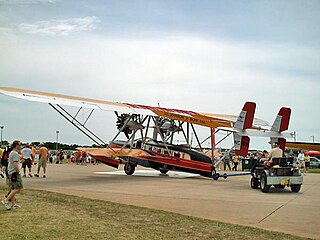
The Sikorsky S-38 was an American twin-engined ten-seat sesquiplane amphibious aircraft. It was Sikorsky's first widely produced amphibious flying boat, serving successfully for Pan American Airways and the United States military.

The Keystone–Loening K-84 Commuter was a single-engine closed-cabin 4-place biplane amphibious flying boat built by Keystone–Loening. It was powered by a 300 hp Wright Whirlwind engine mounted between the wings with the propeller just ahead of the windscreen. It was first produced in 1929.
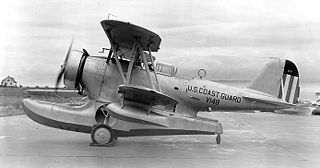
The Grumman JF "Duck" was an American single-engine amphibious biplane built by Grumman for the United States Navy during the 1930s. The J2F Duck was an improved version of the JF, with its main difference being a longer float.

The Grumman FF "Fifi" was an American biplane fighter aircraft operated by the United States Navy during the 1930s. It was the first carrier aircraft with retractable landing gear. It was produced under licence in Canada and known as the Goblin in Canadian service and Delfín in Spanish service.

The Naval Aircraft Factory PN was a series of open cockpit American flying boats of the 1920s and 1930s. A development of the Felixstowe F5L flying boat of the First World War, variants of the PN were built for the United States Navy by Douglas, Keystone and Martin.

The Loening OL, also known as the Loening Amphibian, was an American two-seat amphibious biplane designed by Grover Loening and built by Loening for the United States Army Air Corps and the United States Navy.
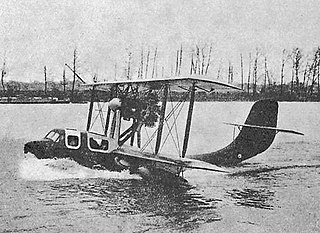
The Franco-British Aviation Model 290 was a French four-seat amphibian flying boat built by the Franco-British Aviation Company (FBA) as a replacement for the Model 17 in French naval service.

The Fairchild 91,, was a single-engine eight-passenger flying boat airliner developed in the United States in the mid-1930s.

The Fokker F-11 was a luxury flying boat produced as an 'air yacht' in the United States in the late 1920s. Technically the aircraft was the Fokker Aircraft Corporation of America's Model 9. It was sold in North America as the Fokker F-11 and was offered in Europe as the Fokker B.IV. By the time the first six aircraft had been constructed, it was already evident that the design was not going to sell well. A few were sold, two to notable multi-millionaires; Harold Vanderbilt and Garfield Wood each purchasing one. One was bought by Air Ferries in San Francisco. The F-11A cost $40,000 but the price was slashed to $32,500 as the depression set in during 1930. The F-11 was a commercial failure.
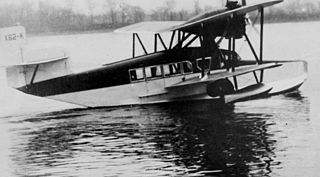
The Loening C-4C, later the Keystone-Loening K-85 Air Yacht following the merger of the Loening and Keystone companies, was an amphibious utility biplane built in the United States in the late 1920s. It was developed by Grover Loening from the C-1 that he had created together with Leroy Grumman, incorporating a new fuselage design. This departed from the characteristic Loening design feature of having a slender, "shoehorn" float projecting from the underside of the fuselage with an engine mounted tractor-fashion above it. Instead, the C-4C had a conventional flying-boat hull, with an enclosed cabin for passengers. The engine was mounted in a separate nacelle on the leading edge of the upper wing.

The Loening S-1 Flying Yacht, also called the Loening Model 23, was an early light monoplane flying boat designed in the United States by Grover Loening in the early 1920s. The aircraft won the 1921 Collier Trophy.
The Curtiss-Wright CW-3 Duckling was an American two-seat amphibian flying-boat developed by Curtiss-Wright from the CW-1 Junior.

The SNCAO 30 was a French single-engined monoplane flying boat two-seat trainer. Although it was ordered into production for the French Navy, only two prototypes were built.

The Loening SL was an American submarine-based reconnaissance flying boat designed and built by Loening Aeronautical Engineering for the United States Navy.

The Eastman E-2 Sea Rover, also called the Beasley-Eastman E-2 Sea Rover, was a light seaplane built in the late 1920s for business and shuttle use.
The Kirkham Air Yacht, also called the Kirkham Gull, was an early monoplane executive transport seaplane.
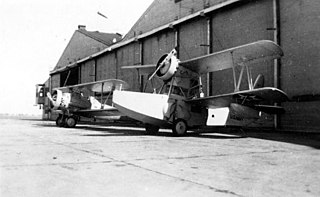
The Loening XS2L was an American biplane scout amphibian developed by Keystone-Loening, for the United States Navy during the early 1930s.

The Loening C-1 Air Yacht was an amphibious airliner produced in the United States at the end of the 1920s.

The Loening M-2 Kitten was a light aircraft produced in the United States at the end of the 1920s, for use aboard capital ships and submarines of the United States Navy (USN).


















